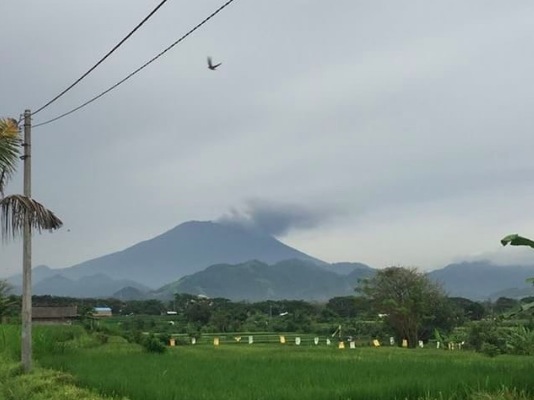Bali’s rumbling Mount Agung volcano has erupted, after months of intensive monitoring and extensive local evacuations.
The eruption–a minor one–observed on Tuesday afternoon, was confirmed by the Volcanology and Geological Disaster Mitigation Center (PVMBG).
“Already, it’s already erupted,” PVMBG head, I Gede Suantika, said on Tuesday.
“There is already ash fall,” Suantika added.
PVMBG is urging that the public remain calm and do not panic and the volcano’s status remains only on the second highest of four levels. The center says it requires further readings on seismicity and structural changes/deformations at the volcano’s crater before upgrading Agung’s status to level IV, despite Tuesday’s small eruption.
“Mount Agung erupted black smoke at 5:35pm. The status is still standby, or level III, and people are encouraged to stay calm,” National Disaster Mitigation Agency (BNPB) spokesman Sutopo Purwo Nugroho tweeted on Tuesday evening.
Nugroho later put out an update, tweeting that the volcano actually started letting smoke out at 17:05.
The black smoke shot up 700 meters from the volcano’s crater with ash blowing “gently” in an easterly and southeasterly direction, according to Sutopo.
“Do not panic and stay away from the radius of six to seven and a half kilometers, as recommended by PVMBG,” Sutopo said.
Gunung Agung meletus mengeluarkan asap dan abu kelabu tebal dengan tekanan sedang pada 21/11/2017 pukul 17:05 WITA. Tinggi letusan maksimum 700 meter dari puncak kawah. Status Siaga (level 3). Radius 6-7,5 km dilarang ada aktivitas masyarakat. Masyarakat dihimbau tenang. pic.twitter.com/bw63qSbh2y
— Sutopo Purwo Nugroho (@Sutopo_BNPB) November 21, 2017
The eruption has been referred to by BNPB has a “phreatic” or steam blast eruption, which occurs when extremely hot magma triggers a steam-driven explosion by heating ground or surface water.
“The eruption of Mount Agung was a phreatic eruption. Seismicity has not indicated the occurrence of a magmatic eruption,” explained Dewa Mertayasa, from the Agung monitoring post in Rendang, Karangasem.
Located in Bali’s Karangasem Regency, Mount Agung is about 75 kilometers from the tourist hub of Kuta.
Agung has been on standby (level III) since Oct. 29 after previously being on level IV “danger” for five weeks, which resulted in the estimated evacuation of more than 180,000 people.
The volcano last erupted in 1963, killing more than 1,000 people.




